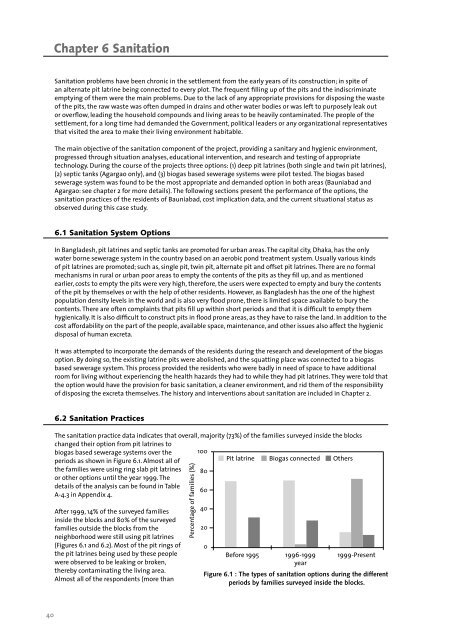Untitled - UNU-IAS - United Nations University
Untitled - UNU-IAS - United Nations University
Untitled - UNU-IAS - United Nations University
Create successful ePaper yourself
Turn your PDF publications into a flip-book with our unique Google optimized e-Paper software.
Chapter 6 Sanitation<br />
Sanitation problems have been chronic in the settlement from the early years of its construction; in spite of<br />
an alternate pit latrine being connected to every plot. The frequent filling up of the pits and the indiscriminate<br />
emptying of them were the main problems. Due to the lack of any appropriate provisions for disposing the waste<br />
of the pits, the raw waste was often dumped in drains and other water bodies or was left to purposely leak out<br />
or overflow, leading the household compounds and living areas to be heavily contaminated. The people of the<br />
settlement, for a long time had demanded the Government, political leaders or any organizational representatives<br />
that visited the area to make their living environment habitable.<br />
The main objective of the sanitation component of the project, providing a sanitary and hygienic environment,<br />
progressed through situation analyses, educational intervention, and research and testing of appropriate<br />
technology. During the course of the projects three options: (1) deep pit latrines (both single and twin pit latrines),<br />
(2) septic tanks (Agargao only), and (3) biogas based sewerage systems were pilot tested. The biogas based<br />
sewerage system was found to be the most appropriate and demanded option in both areas (Bauniabad and<br />
Agargao: see chapter 2 for more details). The following sections present the performance of the options, the<br />
sanitation practices of the residents of Bauniabad, cost implication data, and the current situational status as<br />
observed during this case study.<br />
6.1 Sanitation System Options<br />
In Bangladesh, pit latrines and septic tanks are promoted for urban areas. The capital city, Dhaka, has the only<br />
water borne sewerage system in the country based on an aerobic pond treatment system. Usually various kinds<br />
of pit latrines are promoted; such as, single pit, twin pit, alternate pit and offset pit latrines. There are no formal<br />
mechanisms in rural or urban poor areas to empty the contents of the pits as they fill up, and as mentioned<br />
earlier, costs to empty the pits were very high, therefore, the users were expected to empty and bury the contents<br />
of the pit by themselves or with the help of other residents. However, as Bangladesh has the one of the highest<br />
population density levels in the world and is also very flood prone, there is limited space available to bury the<br />
contents. There are often complaints that pits fill up within short periods and that it is difficult to empty them<br />
hygienically. It is also difficult to construct pits in flood prone areas, as they have to raise the land. In addition to the<br />
cost affordability on the part of the people, available space, maintenance, and other issues also affect the hygienic<br />
disposal of human excreta.<br />
It was attempted to incorporate the demands of the residents during the research and development of the biogas<br />
option. By doing so, the existing latrine pits were abolished, and the squatting place was connected to a biogas<br />
based sewerage system. This process provided the residents who were badly in need of space to have additional<br />
room for living without experiencing the health hazards they had to while they had pit latrines. They were told that<br />
the option would have the provision for basic sanitation, a cleaner environment, and rid them of the responsibility<br />
of disposing the excreta themselves. The history and interventions about sanitation are included in Chapter 2.<br />
6.2 Sanitation Practices<br />
<br />
<br />
The sanitation practice data indicates that overall, majority (73%) of the families surveyed inside the blocks<br />
changed their option from pit latrines to<br />
biogas based sewerage systems over the <br />
periods as shown in Figure 6.1. Almost all of<br />
<br />
the families were using ring slab pit latrines <br />
or other options until the year 1999. The<br />
details of the analysis can be found in Table<br />
<br />
A-4.3 in Appendix 4.<br />
After 1999, 14% of the surveyed families<br />
inside the blocks and 80% of the surveyed<br />
families outside the blocks from the<br />
neighborhood were still using pit latrines<br />
(Figures 6.1 and 6.2). Most of the pit rings of<br />
the pit latrines being used by these people<br />
were observed to be leaking or broken,<br />
thereby contaminating the living area.<br />
Almost all of the respondents (more than<br />
<br />
<br />
<br />
<br />
<br />
<br />
<br />
<br />
40
















